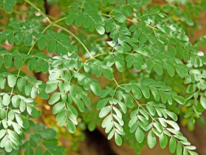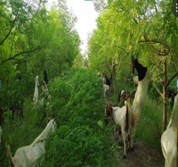One such ideal fodder tree for ruminants is Moringa (Moringa oleifera L.), popularly known as “drumstick tree” for its pods. This fast-growing tree native to Indian subcontinent is grown throughout the tropics for multi-purpose use viz. human food, livestock forage, medicine values, dye, water purification, and for its wide adaptability and ease of establishment. The developing countries which have high environmental temperatures, superior production is very indispensable to fulfill the requirement, so the problem of nutritional deficiency must be solved. The potential ecological heat stress has undesirable influences on growth performance, biochemical pathways, immune responses, electron balance, and physiological variables in animals.
One of the most serious problems facing animal producers, especially smallholder resource-poor farmers, is the ability and price of protein sources. This situation has led to consideration of alternative and less-expensive ingredients with adequate protein content and a balanced amino acid profile. Plant leaf meal and tree foliage are considered as cost-effective protein sources that can be used in ruminant feeding. The availability and price of concentrates, in particular of protein sources, are a serious problem for animal producers, especially for small farms stake holders. Consequently, there is a need for alternative ingredients with high protein content and balanced amino acids profile, and with a suitable cost. Plants leaf meal, forage trees, saltbush and shrubs are good and cheap sources of protein. One of these potential tree forages is Moringa oleifera Lam (syns. Moringa pterygosperm, family Moringaceae), which grows throughout the tropics.
The Moringa oleifera foliage (MF) is widely used for animal nutrition because it is non-expensive source of protein for animal feeding and has the capability to be cultivated under different environmental and soil conditions. The dietary inclusion of MF in animal diets as a feedstuff is accepted for ruminants. MF is best recognized for enhancing the synthesis of the microbial protein in the rumen and has high levels of naturally useful components such as minerals, vitamin C, flavonoids, tocopherols, and phenolic compounds. The MF is an evergreen tree fodder and favorable as a substitute protein source that has been widely used for ruminant feeding. Therefore, the Moringa leaves are abundant throughout the year.
NUTRITIONAL VALUE

The leaves have high protein content with various essential amino acids. In addition to various essential minerals present in the tree, healing properties and health benefits are also associated with this tree. These qualities packaged into a single tree may justify Moringa being termed as ‘Miracle tree’. Besides being used for human consumption the leaves of this tree have been reported to be used as major component in animal feed/fodder.
The level of CP in MF leaf meal varies from 0.18 to 0.28 kg/kg dry matter (DM) and about 470 g/kg of the CP is rumen undegradable protein. Several reports confirmed that the inclusion of MF in the goat’s diets gave a better productivity and growth performance compared to the 100% conventional diets such as sesame meal. Recently, Moringa oleifera leaves are economically sustainable organic material, eco-friendly, and safe feed supplement for animals which improved growth, immunity. and contained antioxidant. The MF in an unconventional diet of up to 75% of DM, enhanced the ruminal fermentation, feed intake, and milk quality and quantity in lactating goats.
Moringa offers a good alternative source of protein with over 28% crude protein in leaves to ruminants wherever they thrive. There has been an increasing interest in the use of Moringa as a protein source for livestock. Laboratory analysis showed negligible amounts of tannins (1 to23 g/kg) in all fractions of the Moringa oleifera plant and high levels of sulphur-containing amino acids. Macronutrients like P, K, Ca, and Mg play key roles in balancing the physiological, metabolic, and biochemical processes of livestock. Moringa leaves contain high amount of macronutrients Mg and K, and can be effectively used to fulfill the dietary and nutritional requirements of livestock animals by mixing of Moringa leaves. Moringa leaves contain a good amount of beta-carotene, vitamin C, calcium, magnesium and iron.
| Nutritional Profile of Moringa oleifera | |
| Metabolizable energy (MJ/kg DM) | 9.30 |
| Organic matter digestibility (%) | 72.0 |
| Ash(%) | 13.2 |
| Crude fiber (%) | 10.0 |
| Crude protein (%) | 28.9 |
| Fat (%) | 6.73 |
| Nitrogen Free Extracts (NFE) (%) | 45.0 |
| Neutral detergent fiber (NDF) (%) | 16.7 |
| Non fiber carbohydrate (NFC) (%) | 38.4 |
| Acid detergent lignin (%) | 6.49 |
| Cellulose (%) | 5.59 |
| Hemicelluloses (%) | 4.66 |
| Calcium (%) | 2.62 |
Since Moringa leaves are rich in protein, so can be used as a fodder for milch animals and other animals like goats. 92% of protein found in Moringa is digestible. Rather, its leaves contain much higher protein than conventional protein supplements like coconut meal, cotton seed cake, ground nut cake, sesame cake, sunflower cake etc. Leaves also contain 8-9% lipids which are rich in Omega-3 fatty acids. Besides these, the leaves possess antioxidant and antimicrobial properties against several fungal species such as E. coli, S. arous, P. aeruginosa, and B. cereus.
MORINGA OLEIFERA FOR GOAT
High environmental temperature is one of the most significant issues which threaten animals raised in tropical climates. In tropical region, the environmental temperatures vary significantly throughout the year. Currently, global warming has severe negative impacts on several agricultural economic sectors, particularly on the livestock industry. It has been documented that tropical region are the areas most affected by global warming; these regions are described by high environmental temperatures for a long time over the year, which cause environmental heat stress for goats. Moreover, it is characterized by a shortage of feed sources and water scarcities. Therefore, producing forages with a high level of crude protein (CP) in these areas is a potential approach for the sustainability of the livestock industry.
The M. oleifera may be considered as a good potential source of supplementary protein for ruminants. The amino-acid supply from this protein concentrate may be of particular nutritional significance as it may cover goat’s protein needs and boost the immune system against diseases.
Moringa leaves, can be used as feed on goat farming. This is because Moringa leaves have a high enough nutritional value to be consumed by livestock. Various active substances are also found in the moringa leaves. This active substance causes Moringa leaves has a myriad of benefits in the health. This is because all the active substances present in the moringa plant are scattered throughout the plant. However, the number of dissemination and concentration is different. The content of active substances in the moringa plant is a secondary metabolite substance. This substance consists of phenols, phenolic compounds, alkaloids, and essential oils. In addition to secondary metabolite, Moringa leaves also contain active compounds glucosinolat and isothiotianat. The active compound is known to have a function as a hypotensive substance. Thats mean that it can improve blood pressure. Moringa leaves that given to goats can improve the performance. Moringa leaves can increase goat body weight, improve the digestion and absorption of nutrients to be more effective. This is as in the research that has been done by N. Sultana et al. He is a researcher from Malaysia UPM University. In his research, the moringa leaves given to goats in vary number. The sex of goats used in the study was male goats. While his age, still in infancy. In the given rations, there are different amounts of moringa leaves. The amount is 0%, 25%, 50%, & 75% even up to 100 percent. Zero percent mean that there is no moringa leaves at all. This is done to know the difference between goat with moringa leaves ration and goat ration without it. Briefly, the results of his research indicate that the more amount of moringa leaves in the ration, the more of rations eaten by goats. In addition, the highest daily weight gain is obtained by goats with a ration of 100% moringa leaves. i.e as much as 61,74 grams per day. This is because the amount of crude protein in the ration will increase with the increase of moringa leaves in the ration. So, the conclusion is that moringa leaves is very useful to be given to goat. Even according to the research, moringa leaves can be used as a single feed in breeding goats
Dr. Rachana Sharma and Dr. Gurpreet Singh
Department of Veterinary Physiology and Biochemistry College of veterinary Science, Rampura Phul Guru Angad Dev Veterinary and Animal Sciences University, Ludhiana















